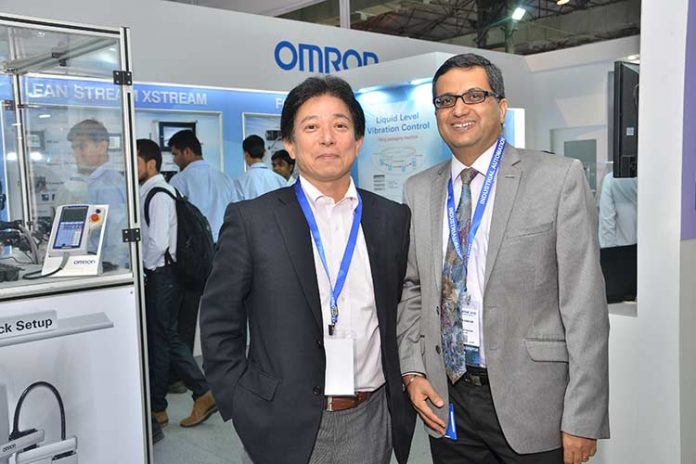Mr. Sameer Gandhi has an experience of over 25 years spanning across multiple disciplines and industries in the manufacturing and automation realms.
As Managing Director, Omron Automation, India, he is in charge of expanding the organization’s footprints in the country by steering the conceptualization and execution of all key strategies related to sales and business development. Leading the team for around 2.5 years now, Mr. Gandhi has been able to contribute significantly towards strengthening the organization’s share in creating intelligence for varied manufacturing sectors such as Automotive, Food n Beverage, Pharmaceuticals, FMCG, Packaging to name just a few. Under his leadership, the company has also been able to diversify its prowess in its sensing & control technology portfolio by introducing futuristic concepts like – Robotics, Total Automation Solution, IoT, etc.
In an exclusive with ELE Times Mr. Gandhi talked about various facets of Indian Automation industry and contribution of Omron towards creating a better technological ecosystem and evolving concepts like the IoT in automation.
Q1. In your long association of over two decades with the Automation Industry. How would you describe the evolution of Automation in India?
Mr.Sameer Gandhi: The scenario is definitely evolving but at a gradual pace owing to many micro and macro level factors, such as ever-increasing need of complying to global standards, the constant need for improving operational excellence, desire for zero defects, productivity and quality improvement, etc.
Talking about India as a destination for Industrial Automation solutions, varied other factors such as rising disposable incomes, expanding middle-class, rise in rural demand, urbanisation are expected to give a considerable spur to manufacturing. There are some more silver linings such as the efforts put in by government in the form of very structured and focused initiatives like Make in India. Efforts are being enhanced to achieve the ambitious target of making manufacturing contribute 25 % of GDP and create 100mn jobs by 2022. All these would surely help automation to grow further in India. As of now, the industrial automation market in India is expected to have a CAGR of 10-12% over a period during 2015-2020.
Q2. What role can Japan and Japanese technology play in strengthening the growth of Indian manufacturing sector?
Mr.Sameer Gandhi: There are two key aspects of manufacturing sector – technology acquisition and absorption – which matter a lot for the sector’s overall growth and evolution. The Japanese companies, known for their technological prowess, continue to be one of the key sources of technology acquisition for the Indian manufacturing sector.
Being the fastest growing economy, India is surely topping the list of promising destinations for companies across the world including the Japanese companies who also view India as a very favorable destination. One of our strengths is the quality and availability of engineers and scientists which play a great role in determining the ability of a nation to develop competitiveness through differentiation.
Both countries are witnessing a very positive mutually-beneficial phase in terms of collaborating over science and technology endeavors which will give fruitful results for the manufacturing sector too. This is quite evident from the recent commemoration of the 30th anniversary of the conclusion of the ‘Japan-India Agreement on Cooperation in the field of Science and Technology’ in March, 2015.
Q3. Can you elaborate on the contribution of Omron India in industrial automation and various business segments it caters to?
Mr.Sameer Gandhi: Omron Automation supports manufacturing excellence worldwide with innovative ‘sensing & control +think’ technologies in the automation domain. Being present in India for over two decades now, we cater to various industrial segments – mainly but not limited to packaging, automotive, material handling, solar, food & beverages, textile, panel building solutions and robotics applications.
Today, we have around 200,000 SKUs and around 30,000 variants in our portfolio – spread across Industrial components, automation systems, sensing & safety, motion & drives, robotics, software, etc. It has been helping manufacturers in the form of enhancing efficiency, productivity, flexibility, accuracy and safety as they scale up the value chain. Recently, we have also introduced the futuristic concept of IoT (Internet of Things) to expand their horizon and help them develop smarter machines based on the concept of ‘i 3’ – Integrated, Intelligent and Interactive.
Q4. What technologies do you think will drive the future of Industrial Automation and what are the major barriers in the way forward?
Mr.Sameer Gandhi: The concept of Industry 4.0 is expected to render remarkable transformation to the sector in near future. It’s actually a melange of many futuristic and advanced concepts and technologies which have the potential of transforming the production scenario in the 21st century, mainly comprises of IIoT, Robotics, Big Data and Analytics, Simulation, Augmented Reality, Additive Manufacturing to name just a few.
The concept is already being adopted by many progressive manufacturing giants across varied sectors.
One of the basic barriers which continues to remains the level of acceptance amongst end users to invest in something that is adding to the cost. Hence the focus on RoI takes centre-stage. Lack of skilled manpower is another challenge. An automation system needs the right set of skills right from the point of conception to deployment to maintenance which becomes very challenging sometimes.
Q5. Give the competitive nature of the Indian market for industrial automation products and systems, what strategic direction you have planned for your company in the coming years.
Mr.Sameer Gandhi: We are leaving no stone unturned to position ourselves as the ‘enablers of Make in India’ and work with our patrons as thorough automation partners providing end to end solutions. We are continuously innovating and are coming up with more value-added propositions and solutions. This year, we have many product launches lined up which will pave a stronger way for strengthening our reach and share. Omron visualizes itself as playing a much bigger role in enabling the manufacturers make in India and enhancing the pool of skills and talent in the automation industry.
Q6. Which major Industry segments does your company serve in the field of Automation?
Mr.Sameer Gandhi: Our key target areas have been Automotive, Packaging, FMCG, F&B, Pharmaceuticals, Panel Solutions, etc. Recently, we have also started working towards the Digital and Infrastructure segments.
Q7. There is a lot of concern on the availability of Skilled Resources in the Industrial Automation space. How would you meet the demand of skilled resources for the growth of your company?
Mr.Sameer Gandhi: I agree that one of the key concerns the sector is facing is the availability of skilled manpower. While we’ve a large talent pool of engineers coming out every year, unfortunately, many of these engineers are not well versed with contemporary technologies like Robotics, IoT, etc. So they need to be ‘skilled up’. Industrial Automation is an investment and if the manufacturer does not have the right set of people to manage it, it is certainly not going to work for them. It is of little use if it is not deployed, operated and maintained by the people equipped with the right skill sets.
I would like to highlight here the efforts Omron is putting in to bridge the gap. We have developed dedicated training centres at Omron where our customers employees as well as our channel partners are provided trainings . We’ve also tied up with AIA to provide equipment and other training facilities to various educational institutes. Another notable initiative is our one-of-its kind Automation Centre at Mumbai, which not only showcases our complete technology prowess but also act as a learning centre for our customers. One of the most notable areas in the centre is the “Tsunagi Lab” which provides the complete integration experience of OMRON to OMRON and third party components so that the team and the patrons are able to learn and handle the technologies which are in the scope of the total solution.
We also have resources designed especially for the young and budding engineers. One of them is an e-learning platform which offers around 15 modules in the automation & control domain free of cost.








